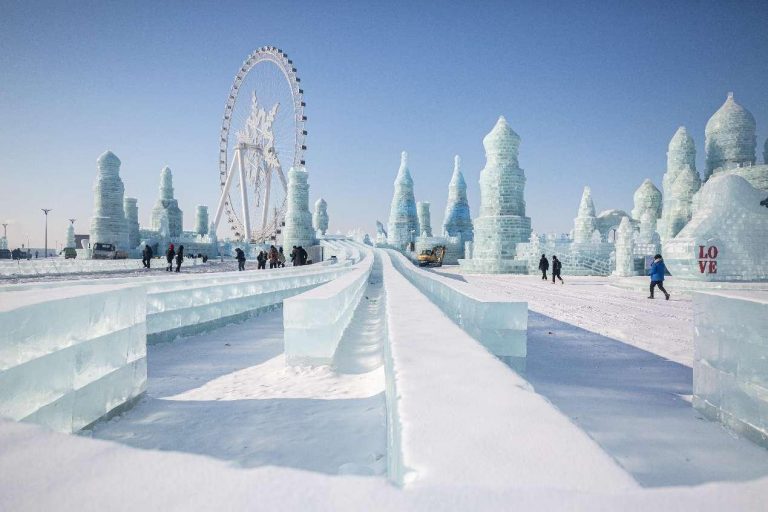
By Guo Xiaolong, Harbin in northeast China’s Heilongjiang province is dressed in silvery white. Harbin Ice-Snow World, a landmark ice-and-snow theme park built on the northern bank of the Songhua River, always bustles with excitement. Just across the river, snow sculptures wearing crowns of snowflakes and draped in pure white “snow robes” captivate crowds of tourists at the Sun Island International Snow Sculpture Art Expo.
During the recent New Year holiday, Harbin received a total of nearly 3.05 million tourist visits and achieved a total tourism revenue of 5.91 billion yuan ($834.1 million), both reaching historical highs.
Behind the booming tourism industry is Harbin’s profound ice and snow culture, including the long-standing provincial-level intangible cultural heritage item – ice and snow carving.
Harbin, known as the “Ice City,” has a long and cold winter, which provides unique natural conditions for the development of winter tourism. As a result, ice and snow carving emerged.
Zhang Weihong, an inheritor of ice and snow carving, said that the beauty of ice sculptures lies in the intricate carvings and crystalline transparency, and snow sculptures, on the other hand, emphasize molded shapes and derive their beauty from pristine simplicity.
According to statistics from 2021, there are over 3,600 full-time ice and snow carving artists in Heilongjiang province. With the emergence of the ice and snow industry, the number continues to rise.
“My master once said that inheritance is not about repetition, but about creation,” Zhang said, adding that it’s important to inherit the intangible cultural heritage item of ice and snow carving and make it accessible, high-quality, and participatory, which calls for innovation.
Today, artists in Harbin have invented colored ice and snow painting that combines ice painting, snow painting, and watercolor painting. They have developed a technique to show rime ice patterns on porcelain wares. Besides, snow sculpture paintings that integrate paper cutting and audiovisual elements have become hot sellers in the gift shops of Harbin Ice-Snow World.
The short preservation time due to seasonal and temperature influences is a major challenge for the artistry of ice and snow carving. To address this, Zhang created new ice and snow carving products that don’t melt, based on the techniques of paper carving and glasswork. This allows the artistry of ice and snow carving to be passed down for longer, he said.
These new products are welcomed by tourists in the gift shops of Harbin Ice-Snow World. “Featuring the beautiful winter scenery of Harbin and at an affordable price, it is a perfect gift for my family,” said a tourist surnamed Hu from southeast China’s Fujian province. Since the opening of Harbin Ice-Snow World, over 1,000 such products designed by Zhang have been sold.
On Jan. 5, Harbin Ice-Snow World was officially crowned the world’s largest ice and snow theme park by Guinness World Records at the 2024 China Ice and Snow Tourism Development Forum, with an area of 816,682.5 square meters. This achievement came from 15 days of hard work by hundreds of ice and snow sculptors and over 10,000 workers.
“It was just fast and furious,” said a tourist surnamed Liu from southwest China’s Chongqing municipality, after taking a 521-meter ice slide at the theme park.
“The continuous high-quality construction of scenic areas and brand building have made Harbin extremely attractive in winter. While enjoying the beauty of the winter scenery, tourists can also experience the cultural charm and unique allure of the exquisite carving skills. This is conducive to the inheritance and innovation of ice and snow carving techniques,” said Zhao Zebin, deputy dean of the School of Management, Harbin Institute of Technology.
With the increasingly diverse demands from tourists, winter tourism places more emphasis on the experience and participation of tourists, and educational trips have become a popular option. In Harbin, a well-known winter destination for educational trips, ice and snow carving is a popular program.
By the Ashi River in Harbin, Zhang led 15 children from Tianjin municipality to experience the charm of ice and snow carving. “We are making colored ice and snow painting. We need to outline the shape in advance on the ice board, then carve and color it,” he explained.
With the expansion of ice and snow carving, more and more companies and universities are joining the ranks of inheriting the technique.
“More than 10 universities in Heilongjiang province are providing courses on ice and snow carving techniques. They often hold relevant competitions,” said Zhang Xin, deputy director of the ice and snow carving committee of the Heilongjiang Artists Association.
Zhang believes that the popularity of winter tourism will encourage more people to learn about this intangible cultural heritage item.










